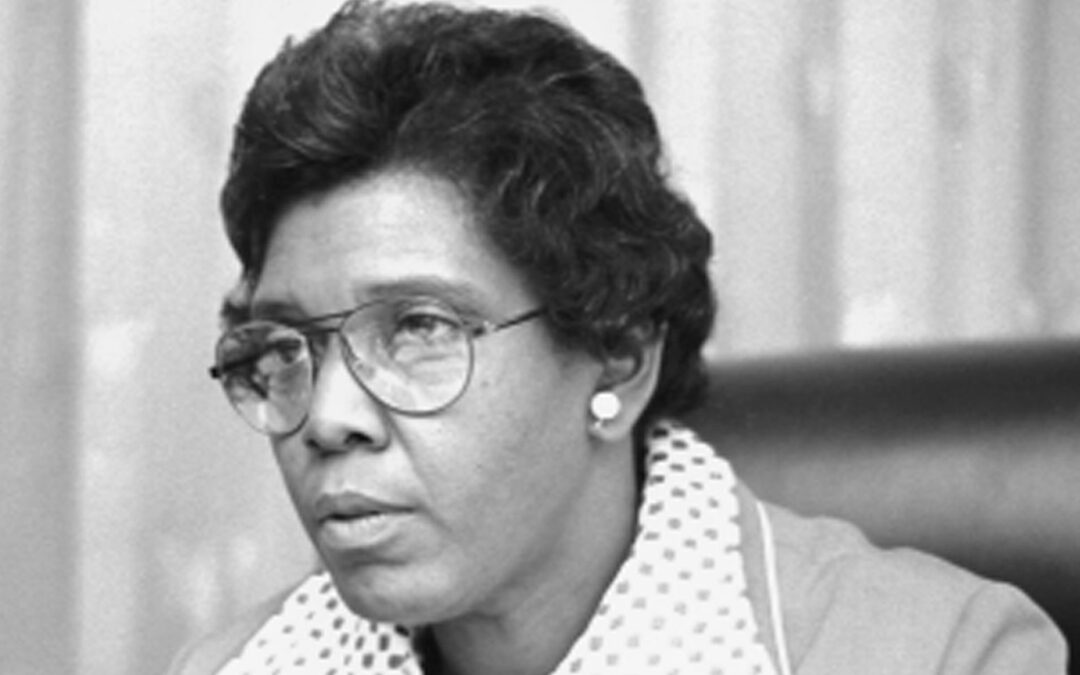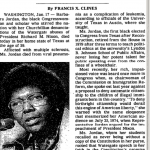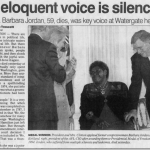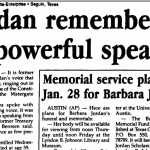Barbara Jordan was a trailblazing legislator, gifted orator, and legendary stateswoman. Image from the U.S. News & World Report Collection at the Library of Congress.
Barbara Charline Jordan
Born: 1936 (Houston)
Died: 1996 (Austin)
Noted For: Barbara Jordan was a Texas attorney who became the first African American (in the post-Reconstruction era) elected to the state senate, and the first African-American woman from the South elected to the United States House of Representatives. She was also the first woman to keynote the Democratic National Convention.
“What people want is simple. They want an America as good as its promise.”—Barbara Jordan, from her 1977 commencement address at Harvard University.
Many trailblazing women are noted for being the first to do something. But Barbara Jordan wasn’t just a “first”—she was one of a kind.
The daughter of laborers and church leaders, Barbara grew up in Houston’s culturally-diverse Fifth Ward district, where she was an honor student at a segregated high school named in honor of Phillis Wheatley, the first African-American woman to publish a book of poetry.
A speech by African-American lawyer Edith S. Sampson (who later became the first black judge in Illinois) inspired Barbara to become an attorney. After graduating magna cum laude in 1956 from Texas Southern University, where she was also a champion debater, Barbara earned a law degree from Boston University. Following a year’s stint on the faculty at Tuskegee Institute in Alabama, she came back to Houston and set up a private law practice.
A Texas legend becomes a national treasure…
After her return to Texas, Barbara expanded into politics, serving as a high-profile campaigner for JFK during the 1960 presidential election. She soon became a candidate herself, running twice but without success for the Texas House of Representatives in the early sixties. Her persistence eventually paid off, however, and in 1966 she became the first woman elected to the Texas Senate, as well as the first African American elected to that legislative body since 1883.
From the Encyclopedia Britannica: “Jordan’s success in Texas politics came from her knowledge of and adherence to the rules of the political process. She went to great lengths to fit in and sought advice on committee assignments. Her own legislative work focused on the environment, antidiscrimination clauses in state business contracts, and urban legislation, the last being a political challenge in a state dominated by rural interests. She captured the attention of President Lyndon Johnson, who invited her to the White House for a preview of his 1967 civil rights message.”
During her time in the Texas Senate, Barbara sponsored or-co-sponsored more than 70 bills. She remained in the state legislature until 1972, when she was elected to represent Texas’s 18th District in the U.S. House of Representatives. She served three terms before retiring from politics in 1979, when she became an adjunct professor of ethics at the University of Texas at Austin Lyndon B. Johnson School of Public Affairs.
While Barbara was a high-profile figure in the Texas civil rights movement and Texas politics from the early days of her career, she was lesser known on the national stage. That all changed on July 25, 1974, the day the 38-year-old congresswoman delivered a 15-minute televised speech during the Nixon impeachment hearings, in which she strongly defended the checks and balances system prescribed by the U.S. Constitution. Her unforgettable voice—commanding, rich, singular— combined with her eloquent oratory—intellectual yet accessible, impassioned but logical—mesmerized colleagues and fellow Americans alike. Today that address is widely regarded as one of the best speeches in 20th-century American history.
On July 12, 1976, Barbara delivered another landmark speech, this time as the first African American and the first woman to deliver the keynote address at the Democratic National Convention. Her remarks still resonate today: “We are a people in a quandary about the present. We are a people in search of our future. We are people in search of a national community. We are a people trying not only to solve the problems of the present, but we are attempting on a larger scale to fulfill the promise of America.”
Voting rights champion…
While in Congress, Barbara was a fierce advocate for the expansion of the Voting Rights Act of 1965 to mandate bilingual election processes in more than 500 jurisdictions, an effort that sought particularly to protect voting rights for Mexican Americans in the Southwest, Native Americans in Arizona, and Asian Americans in New York City.
When President Gerald Ford signed the amendments, Barbara stood over his left shoulder. Later she asked Ford to give her an autographed copy of the cards he read from during his Rose Garden ceremony speech. “That was my first big legislative victory and I wanted a memento,” she later recalled.
Barbara also supported the Equal Rights Amendment and the Community Reinvestment Act of 1977 (which required banks to lend and make services available to underserved populations), as well as other legislative efforts to improve the lives of poor, minority, and disenfranchised populations. Before her departure from the House, she sponsored or co-sponsored more than 300 bills and resolutions, many of which are still in effect today.
A legendary legacy…
During her lifetime, Barbara was honored with the Presidential Medal of Freedom, the Spingarm Medal from the NAACP, and many other awards. She is a member of both the Texas Women’s Hall of Fame and the National Women’s Hall of Fame, as well as the namesake of schools and higher education programs, awards, and public facilities, and a street in Austin. She received honorary degrees from more than 20 universities, including Harvard and Princeton.
In 1996, Barbara passed away at the age of 59 from pneumonia related to the leukemia she had battled for some time, along with the multiple sclerosis she had fought since 1973. Ann Richards, former governor of Texas, delivered her eulogy: “I know that at some point I’m supposed to say that despite all the public acclaim that Barbara was really just like everybody else. But that would be wrong. No matter what else was going on, when you were with Barbara you could never quite shake the feeling that you were in the presence of somebody that was truly great.”
Hundreds of news outlets across the U.S. highlighted Jordan’s legendary voice (both literally and figuratively) in headlines noting her passing in 1996. (Images, l-r: The New York Times, The Washington Post, The Seguin Gazette).
Additional Learning:
Barbara Jordan, National Women’s Hall of Fame
“What Do You Do With A Voice Like That?” by Chris Barton, illustrated by Ekua Holmes
Listen to Barbara Jordan’s famous 1976 Democratic National Convention Keynote Address at American Rhetoric




